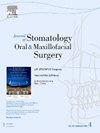Is minimally invasive approach to genioplasty predictable for mentolabial soft tissue? A retrospective cohort study
IF 1.8
3区 医学
Q2 DENTISTRY, ORAL SURGERY & MEDICINE
Journal of Stomatology Oral and Maxillofacial Surgery
Pub Date : 2024-10-05
DOI:10.1016/j.jormas.2024.102103
引用次数: 0
Abstract
Introduction
The aim of this study was to conduct a three-dimensional analysis of the effects on mentolabial soft tissues of three different orthognathic surgery protocols: bimaxillary surgery without genioplasty, bimaxillary surgery with conventional or minimally invasive genioplasty (MIS).
Materials and methods
Pre-operative and post-operative CBCT were superimposed to quantify and ascertain the direction of mandibular movements, and soft tissue were analyzed to evaluate the hard to soft tissue ratio. Data from 97 consecutive patients were evaluated: 30 conventional genioplasty, 36 MIS and 31 no genioplasty.
Results
The impact of the surgical movements on the overlying soft tissues can be consider with stronger correlation in the group No Genioplasty in the whole mentolabial region, stronger correlation in labial and pogonion region in the MIS group and no stronger correlation in the conventional group.
Conclusions
Sutures in the mentolabial region directly interfere with the postoperative impact of orthognathic surgery on soft tissues in mentolabial area, in both the vertical and horizontal directions. A smaller incision – consequently involving less detachment of soft tissues in the region – may promote a lower risk of chin ptosis, in addition to greater suspension of the musculature.
鼻唇沟软组织整形术的微创方法是否可预测?一项回顾性队列研究。
介绍:本研究的目的是对三种不同的正颌外科手术方案对门唇软组织的影响进行三维分析:无基底成形术的双颌外科手术、传统或微创基底成形术(MIS)的双颌外科手术:对术前和术后的 CBCT 进行叠加,以量化和确定下颌骨的移动方向,并对软组织进行分析,以评估软硬组织的比例。对 97 名连续患者的数据进行了评估:结果:结果:手术移动对上覆软组织的影响可被视为与整个门唇区域的无创口组有较强的相关性,与唇和舌骨区域的 MIS 组有较强的相关性,而与传统组无较强的相关性:结论:门颊区的缝合直接影响正颌手术术后对门颊区软组织在垂直和水平方向上的影响。较小的切口会减少该区域软组织的剥离,从而降低下巴下垂的风险,并使肌肉组织更加悬吊。
本文章由计算机程序翻译,如有差异,请以英文原文为准。
求助全文
约1分钟内获得全文
求助全文
来源期刊

Journal of Stomatology Oral and Maxillofacial Surgery
Surgery, Dentistry, Oral Surgery and Medicine, Otorhinolaryngology and Facial Plastic Surgery
CiteScore
2.30
自引率
9.10%
发文量
0
审稿时长
23 days
 求助内容:
求助内容: 应助结果提醒方式:
应助结果提醒方式:


